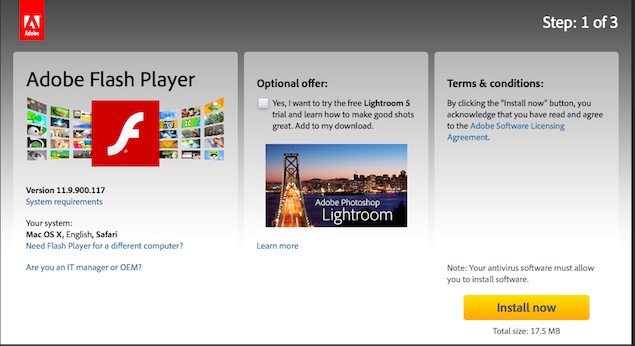- Home
- Laptops
- Laptops News
- Safari for OS X Mavericks includes Flash Player sandboxing
Safari for OS X Mavericks includes Flash Player sandboxing
By Anupam Saxena | Updated: 24 October 2013 14:38 IST

Click Here to Add Gadgets360 As A Trusted Source

Advertisement
Adobe's popular Flash Player utility that allows users to watch videos and browse interactive animated content, has now been made more secure in Apple's Safari web browser on OS X Mavericks, Apple's new desktop operating system, via sandboxing.
Adobe and Apple have worked together to restrict Flash Player's access to the operating system in a bid to make it more secure, as the move will prevent malware attacks that take the browser route to reach out to the user's computer.
Sandboxing essentially puts restrictions on the manner a particular application interacts with the system's operating system, isolating potentially dangerous code.
Talking about the update in a blog post, Peleus Uhley, Platform Security Strategist at Adobe, said that with this week's release of Safari in OS X Mavericks, Flash Player will now be protected by an OS X App Sandbox.
"For the technically minded, this means that there is a specific com.macromedia.Flash Player.plugin.sb file defining the security permissions for Flash Player when it runs within the sandboxed plugin process. As you might expect, Flash Player's capabilities to read and write files will be limited to only those locations it needs to function properly," the post explained.
The post also added that the sandbox now limits Flash Player's local connections to device resources and inter-process communication (IPC) channels and networking privileges, to prevent unnecessary connection capabilities.
Apple had earlier started blocking old versions of the Flash Player, after security vulnerabilities were reported, earlier this year, to prevent any malware attacks. With the sandboxing in place, the browser has become more secure than it was earlier , when it comes to browsing Flash content.
It's worth pointing out that Google's Chrome browser, Microsoft's Internet Explorer and Mozilla Firefox have already deployed sandboxing on Windows.
Adobe and Apple have worked together to restrict Flash Player's access to the operating system in a bid to make it more secure, as the move will prevent malware attacks that take the browser route to reach out to the user's computer.
Sandboxing essentially puts restrictions on the manner a particular application interacts with the system's operating system, isolating potentially dangerous code.
Talking about the update in a blog post, Peleus Uhley, Platform Security Strategist at Adobe, said that with this week's release of Safari in OS X Mavericks, Flash Player will now be protected by an OS X App Sandbox.
"For the technically minded, this means that there is a specific com.macromedia.Flash Player.plugin.sb file defining the security permissions for Flash Player when it runs within the sandboxed plugin process. As you might expect, Flash Player's capabilities to read and write files will be limited to only those locations it needs to function properly," the post explained.
The post also added that the sandbox now limits Flash Player's local connections to device resources and inter-process communication (IPC) channels and networking privileges, to prevent unnecessary connection capabilities.
Apple had earlier started blocking old versions of the Flash Player, after security vulnerabilities were reported, earlier this year, to prevent any malware attacks. With the sandboxing in place, the browser has become more secure than it was earlier , when it comes to browsing Flash content.
It's worth pointing out that Google's Chrome browser, Microsoft's Internet Explorer and Mozilla Firefox have already deployed sandboxing on Windows.
Comments
Get your daily dose of tech news, reviews, and insights, in under 80 characters on Gadgets 360 Turbo. Connect with fellow tech lovers on our Forum. Follow us on X, Facebook, WhatsApp, Threads and Google News for instant updates. Catch all the action on our YouTube channel.
Related Stories
Popular on Gadgets
- Samsung Galaxy Unpacked 2025
- ChatGPT
- Redmi Note 14 Pro+
- iPhone 16
- Apple Vision Pro
- Oneplus 12
- OnePlus Nord CE 3 Lite 5G
- iPhone 13
- Xiaomi 14 Pro
- Oppo Find N3
- Tecno Spark Go (2023)
- Realme V30
- Best Phones Under 25000
- Samsung Galaxy S24 Series
- Cryptocurrency
- iQoo 12
- Samsung Galaxy S24 Ultra
- Giottus
- Samsung Galaxy Z Flip 5
- Apple 'Scary Fast'
- Housefull 5
- GoPro Hero 12 Black Review
- Invincible Season 2
- JioGlass
- HD Ready TV
- Laptop Under 50000
- Smartwatch Under 10000
- Latest Mobile Phones
- Compare Phones
Latest Gadgets
- Realme Narzo 90x 5G
- Realme Narzo 90 5G
- Vivo S50 Pro Mini
- Vivo S50
- OPPO Reno 15c
- Redmi Note 15 5G
- Redmi Note 15 Pro 5G
- Redmi Note 15 Pro+ 5G
- Asus ProArt P16
- MacBook Pro 14-inch (M5, 2025)
- OnePlus Pad Go 2
- Poco Pad M1
- Just Corseca Skywatch Pro
- Honor Watch X5
- Acerpure Nitro Z Series 100-inch QLED TV
- Samsung 43 Inch LED Ultra HD (4K) Smart TV (UA43UE81AFULXL)
- Asus ROG Ally
- Nintendo Switch Lite
- Haier 1.6 Ton 5 Star Inverter Split AC (HSU19G-MZAID5BN-INV)
- Haier 1.6 Ton 5 Star Inverter Split AC (HSU19G-MZAIM5BN-INV)
© Copyright Red Pixels Ventures Limited 2025. All rights reserved.

















